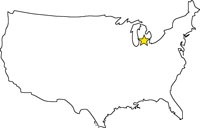Guide to Reflective Sheeting Material Types for Signs (Engineer Grade, High Intensity Prismatic, Diamond Grade)
Posted by Jeffrey Dornbos on 4th Nov 2016

Guide to Reflective Sheeting Material for Signs
Surely there are certain roads that you tend to drive on more than others. If a particular road comes to mind right now, then it is likely you know this road pretty well: you know if the road ever dips; you know when to swerve to miss potholes; and you know when to slow down for the curves. When you drive on this road during the day, it’s probably easy for you to see upcoming dips, potholes, and curves (if you’re paying attention); but when it’s nighttime, it is likely that you rely on your car’s headlights and illuminated warning signs to properly navigate the roadway.
In the United States, there are 3 main types of retroreflective sheeting applied to roadway signs: Engineer Grade, High Intensity Prismatic, and Diamond Grade. Each type varies in design, technology, and purpose.
Engineer Grade Retroreflective Sheeting
The most basic type of retroreflective sheeting is Engineer Grade (EG), which is also referred to as Type I. EG is made up of small glass beads, which are either enclosed in a translucent pigmented substrate or two layers of prismatic sheeting. Engineer Grade retroreflective sheeting doesn’t have a distinctive pattern. It is recommended for commercial and non-critical traffic sign applications.
When EG sheeting is applied properly, it can be expected to deliver retroreflection for five to seven years. Road signs with EG sheeting are visible from 400 to 600 feet away.
High Intensity Prismatic Retroreflective Sheeting
High Intensity Prismatic (HIP) retroreflective sheeting is also referred to as ‘encapsulated lens’ sheeting. It consists of two layers: an outer translucent pigmented layer and an inner reflective layer with glass beads. The two layers are connected by a ‘lattice,’ which gives the sheeting its distinctive honeycomb appearance.
HIP sheeting is made up of prismatic cells. When a light beam lands on a sign with HIP sheeting, the light hits the sides of the prismatic cells and reflects back at a wider angle than it came. This means more light is reflected back towards the source of the light.
This type of sheeting is typically used for highway signs and when applied properly can last up to 12 years. Visibility of signs with HIP sheeting is from 800 to 1,200 feet away.
Diamond Grade Retroreflective Sheeting
The most efficient type of retroreflective sheeting is Diamond Grade (DG). It returns 60% of the light sent its way and is designed to be used on traffic control signs. DG retroreflective sheeting is visible from between 1,300 and 1,600 feet away and can last for 12 years or longer.
Dornbos Sign & Safety, Inc. Supplies Retroreflective Sheeting
If you’re in need of high quality retroreflective sheeting, you can find whatever type, color, and size you need with Dornbos Sign & Safety, Inc. Our company supplies Engineer Grade, High Intensity Prismatic, and Diamond Grade retroreflective sheeting in various colors and sizes, including:
Order Retroreflective Sheeting From Dornbos Sign & Safety, Inc. Today
To order retroreflective sheeting from Dornbos Sign & Safety, Inc., visit our website today. If you are interested in learning more about the retroreflective sheeting supplied by Dornbos or have questions for our team, call us or fill out our online contact form .




